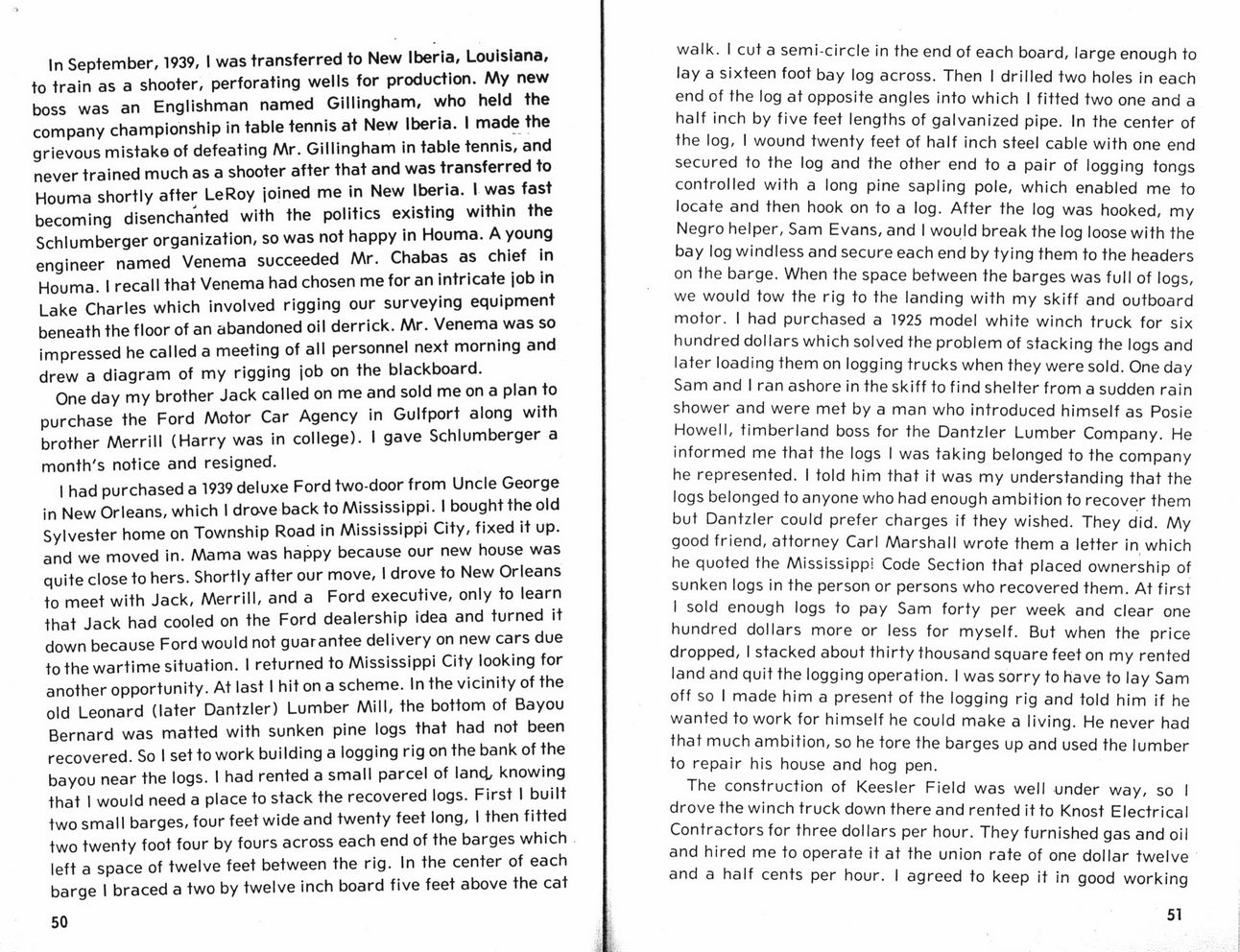This text was obtained via automated optical character recognition.
It has not been edited and may therefore contain several errors.
In September, 1939, I was transferred to New Iberia, Louisiana, to train as a shooter, perforating wells for production. My new boss was an Englishman named Gillingham, who held the company championship in table tennis at New Iberia. I made the grievous mistake of defeating Mr. Gillingham in table tennis, and never trained much as a shooter after that and was transferred to Houma shortly after LeRoy joined me in New Iberia. I was fast becoming disenchanted with the politics existing within the Schlumberger organization, so was not happy in Houma. A young engineer named Venema succeeded Mr. Chabas as chief in Houma. I recall that Venema had chosen me for an intricate job in Lake Charles which involved rigging our surveying equipment beneath the floor of an abandoned oil derrick. Mr. Venema was so impressed he called a meeting of all personnel next morning and drew a diagram of my rigging job on the blackboard. One day my brother Jack called on me and sold me on a plan to purchase the Ford Motor Car Agency in Gulfport along with brother Merrill (Harry was in college). I gave Schlumberger a month's notice and resigned. I had purchased a 1939 deluxe Ford two-door from Uncle George in New Orleans, which I drove back to Mississippi. I bought the old Sylvester home on Township Road in Mississippi City, fixed it up. and we moved in. Mama was happy because our new house was quite close to hers. Shortly after our move, I drove to New Orleans to meet with Jack, Merrill, and a Ford executive, only to learn that Jack had cooled on the Ford dealership idea and turned it down because Ford would not guarantee delivery on new cars due to the wartime situation. I returned to Mississippi City looking for another opportunity. At last I hit on a scheme. In the vicinity of the old Leonard (later Dantzler) Lumber Mill, the bottom of Bayou Bernard was matted with sunken pine logs that had not been recovered. So I set to work building a logging rig on the bank of the bayou near the logs. I had rented a small parcel of lancL knowing that I would need a place to stack the recovered logs. First I built two small barges, four feet wide and twenty feet long, I then fitted two twenty foot four by fours across each end of the barges which left a space of twelve feet between the rig. In the center of each barge I braced a two by twelve inch board five feet above the cat walk. I cut a semi-circle in the end of each board, large enough to lay a sixteen foot bay log across. Then I drilled two holes in each end of the log at opposite angles into which I fitted two one and a half inch by five feet lengths of galvanized pipe. In the center of the log, I wound twenty feet of half inch steel cable with one end secured to the log and the other end to a pair of logging tongs controlled with a long pine sapling pole, which enabled me to locate and then hook on to a log. After the log was hooked, my Negro helper, Sam Evans, and I would break the log loose with the bay log windless and secure each end by tying them to the headers on the barge. When the space between the barges was full of logs, we would tow the rig to the landing with my skiff and outboard motor. I had purchased a 1925 model white winch truck for six hundred dollars which solved the problem of stacking the logs and later loading them on logging trucks when they were sold. One day Sam and I ran ashore in the skiff to find shelter from a sudden rain shower and were met by a man who introduced himself as Posie Howell, timberland boss for the Dantzler Lumber Company. He informed me that the logs I was taking belonged to the company he represented. I told him that it was my understanding that the logs belonged to anyone who had enough ambition to recover them but Dantzler could prefer charges if they wished. They did. My good friend, attorney Carl Marshall wrote them a letter in which he quoted the Mississippi Code Section that placed ownership of sunken logs in the person or persons who recovered them. At first I sold enough logs to pay Sam forty per week and clear one hundred dollars more or less for myself. But when the price dropped, I stacked about thirty thousand square feet on my rented land and quit the logging operation. I was sorry to have to lay Sam off so I made him a present of the logging rig and told him if he wanted to work for himself he could make a living. He never had that much ambition, so he tore the barges up and used the lumber to repair his house and hog pen. The construction of Keesler Field was well under way, so I drove the winch truck down there and rented it to Knost Electrical Contractors for three dollars per hour. They furnished gas and oil and hired me to operate it at the union rate of one dollar twelve and a half cents per hour. I agreed to keep it in good working

True, Jim Yours Truly-027